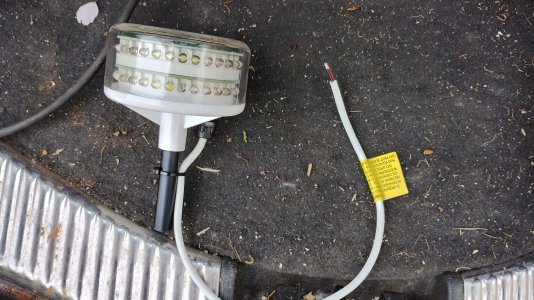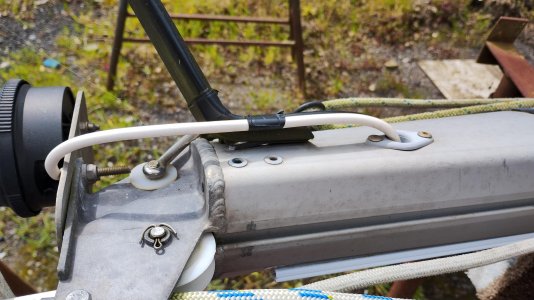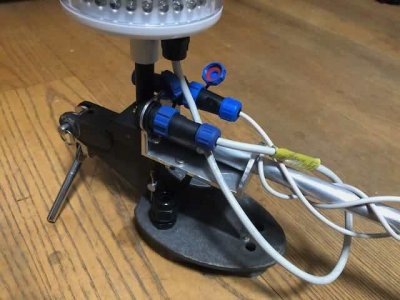You are using an out of date browser. It may not display this or other websites correctly.
You should upgrade or use an alternative browser.
You should upgrade or use an alternative browser.
Best way to make this connection?
- Thread starter ridgy
- Start date
ProDave
Well-known member
What is wrong with old Tricolour?
I would not want one with a short captive cable. We just replaced ours and that had cable terminations inside, just like your old one would have.
I would not want one with a short captive cable. We just replaced ours and that had cable terminations inside, just like your old one would have.
KevinV
Well-known member
That's certainly what I have done, with the connection in the mast to prevent UV damage and a drip loop on the outsideNew tricolour, and current arrangement. Thinking inline crimps with a couple of layers of heat shrink but wondering about UV resistance.
Alex_Blackwood
Well-known member
Can you not open up the unit and connect internally with existing cable?New tricolour, and current arrangement.View attachment 175971View attachment 175972
Thinking inline crimps with a couple of layers of heat shrink but wondering about UV resistance.
Refueler
Well-known member
There are good corrosion resistant connectors small enough to do this job ... allowing easy removal of unit if faulty / repairs etc. I do not like permanent hardwiring for such items.
Stemar
Well-known member
While I agree that an internal connection would be a much better solution, assuming it isn't practicable, I'd be inlined to slip some small shrink wrap over the wires and a bigger bit over the outer and solder them. Shrink the little wraps over the solder joint and the big one over everything.
If it's really cheap and nasty, it's possible the wire might be aluminium, and good luck with soldering that, in which case I'd use heat-shrink crimp connectors, plus more heat-shrink as above.
I get Refueler's argument, but a solder connection's easy enough to undo.
If it's really cheap and nasty, it's possible the wire might be aluminium, and good luck with soldering that, in which case I'd use heat-shrink crimp connectors, plus more heat-shrink as above.
I get Refueler's argument, but a solder connection's easy enough to undo.
rowlock
Member
littledancersadhu
Member
All ways terminate in the fitting.
Kwik Decision
Active member
I've just fitted one of those lights and used these connectors, with a length of glue lined heat shrink over the top:
Amazon.co.uk
Amazon.co.uk
justanothersailboat
Well-known member
I wouldn't, personally, worry about it not having an internal connection. Many models of the new LED navigation lights are fully sealed and potted right down to the wire tail. There's no realistic prospect of inspecting inside them, but they ought to last very well (and most do). An internal connection would presumably have terminals or something and become a point of failure.
I'd just use heatshrink crimps inside an outer heatshrink tube. (I did exactly that, when I replaced all my nav lights with LEDs that came with wire tails). I think they're more robust and sealed than solder joints. This is realistically not going to get disconnected very often, losing a bit of the tail when you do is no big deal. Often the tail is long enough that you can get the join inside the cable channel of the mast - you can stagger the two wires' crimps to reduce bulk, at the expense of using up a bit more of the tail.
I'd just use heatshrink crimps inside an outer heatshrink tube. (I did exactly that, when I replaced all my nav lights with LEDs that came with wire tails). I think they're more robust and sealed than solder joints. This is realistically not going to get disconnected very often, losing a bit of the tail when you do is no big deal. Often the tail is long enough that you can get the join inside the cable channel of the mast - you can stagger the two wires' crimps to reduce bulk, at the expense of using up a bit more of the tail.
KompetentKrew
Well-known member
Bet you £1 it's not LED.What is wrong with old Tricolour?
And putting LED festoon bulbs in an incandescent fitting is rubbish.
PaulRainbow
Well-known member
Sorry, those connectors are absolute rubbish.I've just fitted one of those lights and used these connectors, with a length of glue lined heat shrink over the top:
Amazon.co.uk
Refueler
Well-known member
Sorry, those connectors are absolute rubbish.
I have to agree ... I watched a video of them - seemed so easy and good .... till they get in your hands and you try it yourself ...
I had a simple RC motor lead to extension to make ... after 4 connectors failed to make secure joints ... I gave up.
I have a big boxfull of them sitting on the side now ...
For something at the mast head that is not easy to get to if it goes wrong ... I prefer corrosion proof plug / socket or hardwired joint ..
PaulRainbow
Well-known member
One of my customers used them to join the masthead lights wiring after having the mast off. They looked tidy, but when pulled the wires heat shrink stretched until it broke, revealing wires with no solder on them, they were just held together with the glue and heat shrink.I have to agree ... I watched a video of them - seemed so easy and good .... till they get in your hands and you try it yourself ...
I had a simple RC motor lead to extension to make ... after 4 connectors failed to make secure joints ... I gave up.
I have a big boxfull of them sitting on the side now ...
For something at the mast head that is not easy to get to if it goes wrong ... I prefer corrosion proof plug / socket or hardwired joint ..
A better option where this type of connection is suitable would be the ones that you crimp and then heatshrink (glue lined).
Last edited:
Refueler
Well-known member
One of my customers used them to join the masthead lights wiring after having the mast off. They looked tidy, but when pulled the heat shrink stretched until it broke, revealing wires with no solder on them, they were just held together with the glue and heat shrink.
A better option where this type of connection is suitable would be the ones that you crimp and then heatshrink (glue lined).
I have a feeling that the heat ones could be used like a crimp - but certainly not where inaccessible for repair !!
But yes - they are bl**** useless ! To think I was going to entrust expensive models to them !!
ridgy
Well-known member
Yes this is exactly the reason.Bet you £1 it's not LED.
And putting LED festoon bulbs in an incandescent fitting is rubbish.
Stemar
Well-known member
They seem like such a good idea!. I, too, have a boxful that this thread reminded me that I need to bin. The heat-shrink crimp connectors do work, though, provided you use the proper crimping pliers. The ones that double as strippers just don't do it.One of my customers used them to join the masthead lights wiring after having the mast off. They looked tidy, but when pulled the wires heat shrink stretched until it broke, revealing wires with no solder on them, they were just held together with the glue and heat shrink.
A better option where this type of connection is suitable would be the ones that you crimp and then heatshrink (glue lined).
Refueler
Well-known member
Bet you £1 it's not LED.
And putting LED festoon bulbs in an incandescent fitting is rubbish.
LED replacing filament ? Why rubbish ? Many people do just that - I've done it on various and work fine ... power demand is significantly reduced, lamps can be easily replaced instead of whole unit ...
st599
Well-known member
If you do replace incandescent with LED,you need to ensure that the colour of the Red and Green filters in the housing matches the LED output. Or you end up with a very dim sidelight.
Refueler
Well-known member
If you do replace incandescent with LED,you need to ensure that the colour of the Red and Green filters in the housing matches the LED output. Or you end up with a very dim sidelight.
Fine ... but that does not mean LED in older filament based lights are rubbish.
I have replaced filament with standard white LED and the only difference has been usually brighter light ... with very low power draw.
Other threads that may be of interest
- Replies
- 21
- Views
- 1K
- Replies
- 8
- Views
- 563
- Replies
- 15
- Views
- 416
- Replies
- 10
- Views
- 584
Members online
- tjbrace
- Motor_Sailor
- Davy_S
- DanTribe
- flaming
- BarrytheViking
- sy-Anniina
- Bob@SYH
- Bagbog
- FatherTed
- NorthUp
- veshengro
- Dellquay13
- Stingo
- Aquanaught
- nathanglasgow
- st599
- ridgy
- chriscallender
- Daedelus
- 38mess
- MoodySabre
- JOHNPEET
- geoid96
- PlanB
- Buck Turgidson
- PCUK
- LoneHort
- Momac
- Nexti
- Wansworth
- WF36
- Mark-1
- SimonMackenzie
- jon711
- Den100
- ex-Gladys
- BGW
- Calva
- kelcha
- thamesS23
- Beneteau381
- Dee Bee
- ghostlymoron2
Total: 871 (members: 63, guests: 808)



